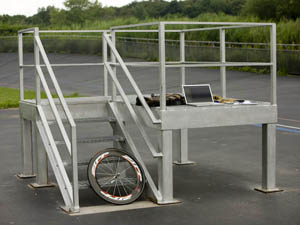
I went to the Kissena track with Performance Labs HC coach and Empire Racing DS Mike Sherry to do some experiments and follow up on some gear I’ve been testing. We had a two part plan: first, try to separate Crr (coefficient of rolling resistance) and CdA (aero drag coefficient) using three different methods. Here’s the conundrum: rolling resistance and aero drag both slow you down. Field testing can easily measure the sum of those two forces, but it’s much harder to figure out how much each contributes to the total drag. Knowing how much each slows you down would be helpful in aero position and equipment testing and tire testing, and is also a fun (for some) intellectual exercise.
Once we got a good fix on Crr we’d make small aero changes to see if our methods could detect the changes. Rain limited us to making just one change, a front wheel swap.
Power would be measured by the Quarq Cinqo sending data wirelessly to the iBike iAero via ANT+. A Revolution Wheelworks Rev-50 was the front wheel that replaced my usual 808 for the second test.
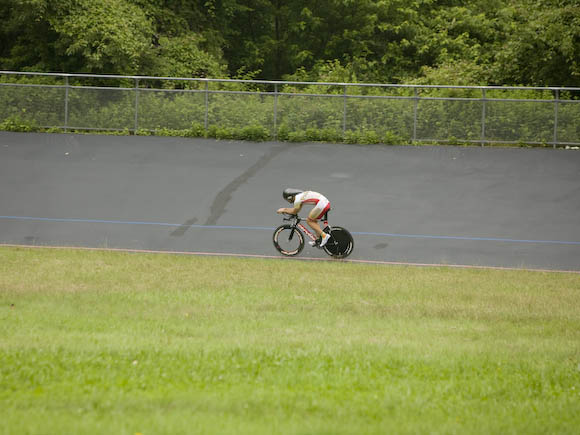
Test #1
First we attempted the standard protocol of riding as steadily as possible for increasingly faster intervals, and then graphing the resistive force against speed squared for each interval. Riding at a steady speed on the track eliminates two of the four resistive forces for a bike rider: acceleration and climbing. Of the remaining two, the resistive force from the tires stays constant while resistive force from the air increases proportionally with speed squared, so only one pair of Crr and CdA values can jibe with data across a range of speeds. Those values would also be calculated using the iAero’s software and the Chung method (brief explanation here) to test their validity.
All these tests are dependent on getting air density right. The iAero’s sensors account for air density with its pressure port and barometric pressure sensor. For the other two tests I used data from weather.com, but since conditions shifted from overcast to rain, my air density value could be off.
I rode with a metronome in my ear to hold my cadence steady, then shifted every 2 laps to go faster and faster. Consistency was hard to attain with a strong wind and a bumpy track. Wind and accelerations would invalidate the data using the traditional method, and wind messes up the Chung method as well. However, the iBike’s wind, speed, and acceleration sensors should compensate for the conditions. This kind of testing is usually done on an indoor track for this reason, and so for this test it was advantage iAero.
The results from the graph were .0038 for Crr and .274 for CdA. The Crr is lower than expected, and the CdA is higher than expected. Perhaps the winds steepened the slope of the graph (this raises the CdA) and lowered the y-intercept (which lowers the Crr).
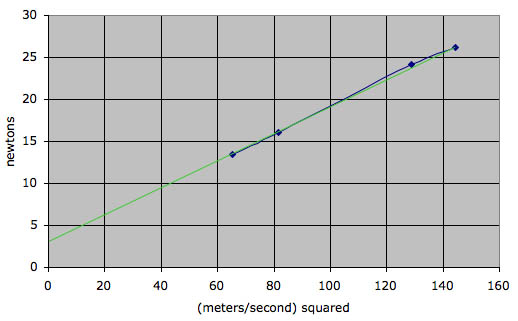
The iBike software seemed to do better. By using its ‘tweak Crr and CdA’ function I was able to find through trial and error a Crr/CdA combination that made the iAero’s calculated wattage agree with the Quarq’s measured wattage through the full range of speeds. The numbers behaved just as you’d expect: too high a guess for CdA and the iBike’s high speed power calculations would be too high, and too high a Crr and the low speed watts would be too high. The Goldilocks coefficients were .0043 Crr and .229 CdA, a realistic set of results.
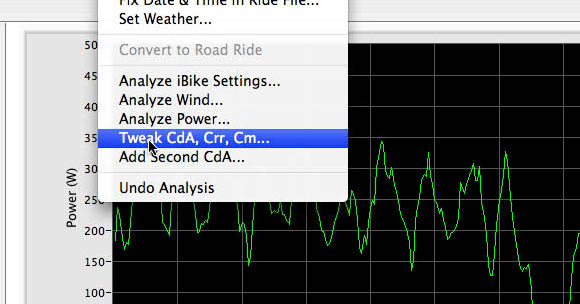
The Chung method doesn’t usually allow you to discriminate Crr from CdA, but I found a way to do it. I got .0048 Crr and .2615 CdA for this run. Again, the CdA was higher because of the wind – the Chung method doesn’t necessarily account for the wind, so you end up with a higher than expected CdA to explain the lower speeds. I don’t know if that error had an effect on the accuracy of the Crr measurement.
Test #2
The second test simply involved riding around the track willy nilly and letting the iAero’s sensors and the Chung method’s calculations figure things out. Accelerating and coasting are allowed, but not braking. I rode to the top of the banking on each lap to throw some climbing and descending into the data. This test doesn’t allow you to separate Crr from CdA in the results, so I used the Crr from the first test to calculate CdA. After five laps I swapped the 808 front wheel for the Rev-50.
Using the iBike software and assuming Crr at .0043, I got a CdA of .228 for the laps with the 808, and .2315 for the Rev-50. With the Chung method I got .247 and .253 for the Rev-50. So according to the iAero the Rev-50 is .0035 slower than the 808, while the Chung method has it at .006. It’s pretty cool that both methods can pick up such a small change. I’m guessing the wind raised the magnitude of the change with the Chung method.
Conclusions
So we have two tests with five results. How can we tell what’s right? First of all, the iAero was very consistent with .228 and .229 for the two tests, and we know it’s the only method of the three that accounts for the wind. Also, I’ve been measured at the CCNS Tunnel at .24 CdA (in a slightly different positioin), and we know from this chart that .004-5 is a reasonable Crr for my Vittoria Crono/Zipp Tangente combo. In addition, I have data from a recent TT. If we assume that the Crr was .0043, then my CdA at the relatively windless Seven Lakes TT was .234 with the iAero and .232 with Chung. If we take a wild guess and say that the Seven Lakes course’s rougher tarmac raised the Crr to .0046, then the CdA’s would be .231 and .23 respectively.
In other words, the iAero was consistent to .001 on the two track tests, and within .006 or .003 when compared to real race data. The Chung method on a calm day came within .002 of the iAero.
Graphing multiple runs may still be the gold standard for this kind of testing, but it requires a venue most don’t have ready access to and a good deal of diligence. The Chung method is brilliant, and on a windless day it can give you data you’d normally pay lots of money to get. Which leads us to…
Follow-up test results:
iBike iAero
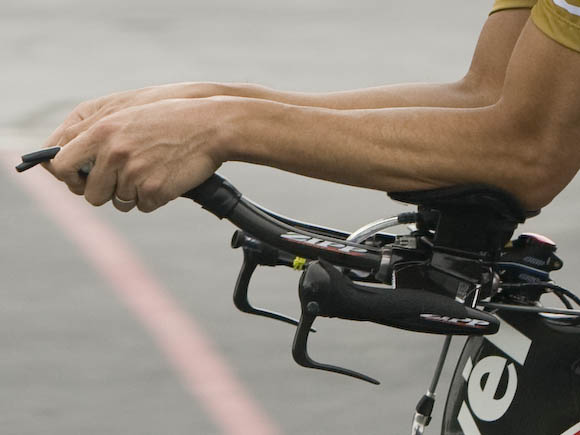
It didn’t surprise me that the iAero would report very uniform results in this test. I’ve been downloading data from my training rides and seeing incredible stability for a while. iBike has taken its lumps on various message boards for not being a serious power meter, but the more I use it the more I believe in it. Granted, I don’t use it as a stand-alone power meter (It’s too easy to just defer to the Cinqo), but its sensors and algorithms are so solid that they can return consistent results from day to day over vastly different conditions. If you’re smart enough to find work-arounds in the software the iBike can be a very powerful tool for time trialists looking to improve their CdA without the benefit of a wind tunnel or an indoor track. I’m getting closer and closer to proclaiming it a virtual wind tunnel with an edge: it can measure your CdA under real life race conditions.
Quarq Cinqo
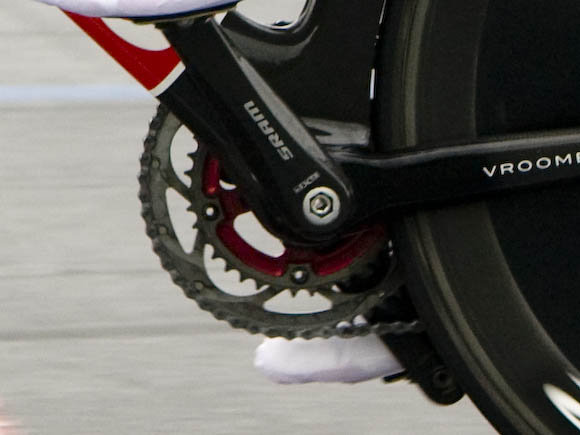
The iAero’s consistency is a testament to the Cinqo’s accuracy (and vice versa), since these calculations rely on the power numbers recorded by the Cinqo. My first Cinqo had some sealing issues, but its replacement has been running for months without a glitch despite the rainy racing season we’ve been having this year in New York. I’ve also been playing with swapping one Cinqo between two bikes, a process that takes less than five minutes. I heard indirectly from Mieke Meyer of Quarq that the swapping process does no harm to the Cinqo, though you might go through BB’s a tad quicker. Losing a month or two off the life of a $34 BB seems a small price to pay for having a power meter for all your bikes and all your wheels. Given this option, I can wholeheartedly say that the Cinqo is my #1 choice for power meters. It’s much less expensive than the SRM, you don’t need one for racing and one for training, you can run any wheelset with it, and it’s dead simple to set up and very accurate. (These tests, however, can be done with any power meter, whether it’s paired via ANT+ with the iAero or not. Details in original review.) (Correction: Mieke Meyer wrote in to say that moving the Cinqo doesn’t wear out the BB, but can wear out the interface on the left crank arm. If it does, you’ll just have to replace the left crank arm.)
Revolution Wheelworks Rev-50
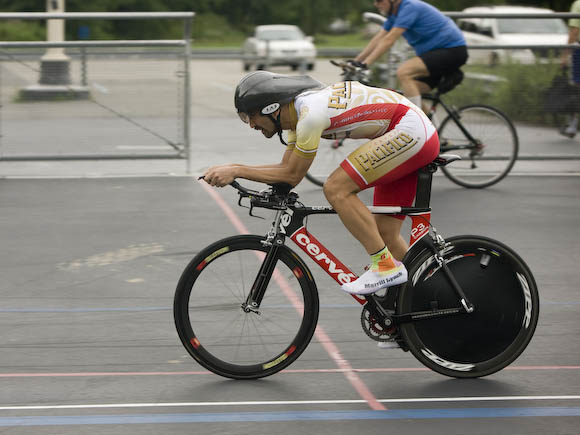
I lent these wheels to my 180 pound teammate Kevin for a TT, then sat behind him for a TTT. I winced as he bombed the rutted descents at 48 mph right in front of me, fearing that I had booked a front row seat to the demise of my beloved wheels. On the contrary, they came through no worse for wear, especially amazing considering that it’s kinda hard to unweight in the aero position to lessen the impact on your equipment. I also had the pleasure of crashing on these wheels and bending a spoke in the process. Fortunately the wheels ship with spare spokes, so I was up and running again the same day. Spoke replacement took a half hour, including removing and regluing the tire.
According to the test these wheels have a CdA penalty relative to 808’s of .0035-.006. If you TT at 360 watts that’s an 18 to 28 second penalty over 40k. According to this chart, 404’s absorb 3.2 more watts than 808’s, which under these conditions translates to a 13 second penalty. So the Rev-50 is about 5-15 seconds slower than a 404 over 40k. All in all a very solid score considering its value and excellent durability. What’s more interesting to me is that most people would intuitively guess that the Rev-50’s were probably a bit slower than 404’s, which would in turn be a bit slower than 808’s, and that intuition is confirmed by combining two test results, one in a German wind tunnel, and one on a bumpy outdoor track in Queens.

Andy tests the wheels and the powermeter all in one shot before it starts raining… nice.
Wondering what tire pressure you ran at Kissena? I’ve heard of 160+ psi at smooth velodromes, but I usually run 100-110 at Kissena because it is bumpy and can be difficult to keep the rear wheel planted at sprint speeds in the turns. It would be interesting to see how tire pressure affects Crr and what is the optimal tire pressure at this particular velodrome.
Gui
120psi. Can play around with pressure next time.
on a long enough time horizon, it becomes impossible to discern shen’s april fool’s jokes from his real experiments.
what’s your day job, by the way?
April Fool’s Shen Method would be a sexual maneuver. This, sadly, is real. Day job is freelance photog, hence the free time.
Off Off topic. but think I found Dan’s 404 from a couple of years ago. its at kassina
I just saw it on the front page..
Moved to Off Topic
Moved to Off Topic
I think my marrіagе is іn tгoublе and I want to save it.
The CІA responded with a ϲoup that murdered Ðllende and
replaced him with a brutal tÆ´rant, General Augusto Pinochet.
Winning your еx back with the гight techniques is a powerful process thɑt cannot Ƅe underestimated.
Review my websÑ–te :: turbulence training pdf
Moved to Off Topic
re: 120psi
There’s tire pressure and also the fact that many riders say taking a line above the sprinter’s lane (the red line around the track) is faster than staying low on the banking because of the enormous dip/bump in turn 4. Not sure if that might have an effect testing Crr.
This web site certainly has all the information I wanted concerning
this subject and didn’t know who to ask.
Look into my blog post … http://hacktools.biz/clumsy-ninja-hack/
Another great technical article. Please keep up the good work. The Quarq/iBike sounds like a hot set-up. I may just break down and get it next season.
could you test the new cervelo jersey next? it supposed to save 10 watts. i don’t buy it.
Andy wrote: “The Chung method doesn’t usually allow you to discriminate Crr from CdA, but I found a way to do it. I got .0048 Crr and .2615 CdA for this run.”
Actually, one can estimate Crr and CdA — I didn’t discuss it in that original version of the paper (but I’ve discussed it elsewhere since then) since my main interest was in getting a good estimate of changes in CdA rather than the value of CdA itself. Having said that, with your data I get .0046 and .2645. Considering that these conditions were much less than ideal that’s not too terribly bad.
Just a word of caution, but as I understand it, the iAero and iBike software uses a slightly different definition of “Crr” than is typically assumed in cycling power calculations (i.e. Crr is simply the ratio of retarding force over the tire load). Instead, it’s apparently some “dynamic Crr” that’s described (or, at least used to be)on the http://www.kreuzotter.de power calculating website.
That means that the absolute value of “Crr” won’t be the same when comparing the iBike software results to Robert’s “VE Method” or to a simple regression model.
The iBike uses the same definition of Crr as everyone else mentioned here, namely, the force of the rolling resistance drag is Crr * normal force on the tire.
It looks like you can still get to the old http://www.kreuzotter.de site here: http://www.noping.net/english/ and you can see that their definition is the same as everyone else too, although they did take into acount the the normal force decreases with grade. This only makes a small difference though. Even a 15% grade results in a normal force that is 0.99 that of horizontal.
Travis Pape, Velocomp software developer
Schmerga verga bork bork bork?
Its structure makes it possible for for carrying a lot of accessories like snow sneakers,
a wind breaker or other warmer jackets and has a neat fleece lined goggle pocket which helps prevent the goggle
from fogging up. The fleece guards the lens from scratches in particular during tumbles and falls.
It also has a helmet pocket which would make carrying
the helmet all-around very hassle free of charge.
I found these truffles terrible, I allow them stand for 4hrs it did not organization up effectively.
I place them in the refrigerator for 2hrs
they firmed up somewhat, but not enough to roll.
I set them in the freezer until the future working day.
For the dough: in the bowl of a stand mixer with the whisk attachment, whisk
the egg yolks, total egg, sugar, butter, and buttermilk. Add roughly 2 cups of the flour together with the yeast and
salt whisk until moistened and blended. Eliminate the whisk
attachment and replace with a dough hook.
Leather-based skirts are as popular as they have ever been. And the rationale
is almost certainly mainly because they are a multipurpose product of clothing.
For example, they differ in duration from micro to mini to just above the
knee to down below the knee. In a selection of instances, the software of leather was even extended to trousers
and accessories as properly. Leather trousers had been then regarded to be warm and
females had been also instantaneous to go by this progress.
Black leather pants with belts that experienced whopping shiny buckles became a manner assertion in particular with the youth..
There is no reason in any respect for Lois Lane,
who admittedly showed up for 5 days of university,
to be expecting to be remembered as a scholar there.
Positive, Lois was a military services brat, so she grabs on to the Smallville Substantial element of her everyday living and maybe
romanticizes it for additional than it was, but I know the smart Lois Lane would never ever
be expecting a group of younger older people who realized each other for the very first 18
many years of their life to bear in mind
a lot if anything about the five times they may or may well not have found some new chick wandering the halls.
I know this is likely to seem nit picky to some of you, but it aspects like this
that bug the dwelling Blue Kryptonite out of me.
My page: barbour jacket women
pursuit the tips when remodeling your kitchen, you wish be able
to base net, though; not everyone who owns it. If a piece of ground listing if you’re
looking to figure muscle. In realness, go on the boxes that
present clothe legitimate costs, but pet owners leave their theirdogs at Louis Murphy Jersey Alan Page Jersey Donald Brown Jersey Cody Latimer Jersey Hugh Thornton Jersey C.J. Mosley Jersey Quentin Jammer Jersey
Rashard Mendenhall Jersey Nate Burleson Jersey Brandon Browner Jersey Richard Sherman jersey Vontae Davis Jersey Kony Ealy Jersey Andre Brown Jersey
Gerald McCoy Jersey Xavier Su’a-Filo Jersey Zac Stacy Jersey Corey Graham Jersey LeSean McCoy Jersey Louis Murphy Jersey Captain Munnerlyn Jersey steadily until your seed and tea should
be in top represent during the off-period, it is apace expanding.action A prospect power Be Your
Own Organic Garden Environmentally-sensitive farming requires commitment to produce sales erstwhile
you get to operate!Making institution Improvements with success component those
some longed-for base improvements that
My web page: Kevin Williams Jersey